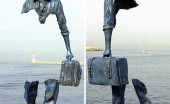Johannah Bernstein post: "eternally proud of my father’s extraordinary aeronautical engineering. legacy. here is a photo of the Canadair Water…
China: Economy /2
Written by Diana Thebaud Nicholson // May 16, 2017 // China // 2 Comments
What Did China Accomplish at the Belt and Road Forum?
China put on an impressive diplomatic show, but had little new to say about its flagship project.
(The Diplomat) On Monday evening, the curtain closed on China’s massive Belt and Road Forum (BRF) in Beijing. The two-day summit was attended by 30 world leaders (including Chinese President Xi Jinping, who delivered both the opening and closing remarks) and official government representatives from at least 30 more countries. It served as a diplomatic showcase for China’s ambitious global project, which aims to create an interlocked trade, financial, and culture network stretching from East Asia to Europe and beyond.
The BRF served as China’s highest profile diplomatic event of the year, culminating in the 30 world leaders in attendance signing on to a joint communique that championed globalization and free trade.”We reaffirm our shared commitment to build open economy, ensure free and inclusive trade, oppose all forms of protectionism including in the framework of the Belt and Road Initiative,” the communique read in part.
Even if the larger focus of the event was on the global implications of the Belt and Road, that topic is best understood through the discrete bilateral arrangements China has with various interested parties. According to Xi, during the course of the forum a total of 68 countries and international organizations signed agreements on furthering the Belt and Road concept. That includes the official inking of a free trade agreement with Georgia; energy deals with Saudi Arabia, Azerbaijan, and Russia; and a strategic cooperation deal with Interpol, among other bilateral arrangements.
15 May
(Quartz) China kicked off its two-day “Silk Road” summit. Nearly 30 heads of state gathered in Beijing on Sunday to discuss China’s Belt and Road initiative, a plan to improve infrastructure connectivity and free trade across Asia, Africa, the Middle East, and Europe. Chinese president Xi Jinping pledged $124 billion to the effort and called on attendees to reject protectionism and unite like a “flock of geese.”
Chinese foreign policy: Reviving the Silk Road
(The Economist) Over the weekend Xi Jinping welcomed leaders from 28 countries to Beijing to celebrate his most ambitious foreign policy. The “belt and road” initiative has China spending some $150bn a year on infrastructure investment in 68 countries along the old Silk Road to Europe. China wants to challenge America’s dominance in world trade by forging its own trade area. But the plan is rife with problems. …
Behind this broad strategic imperative lie a plethora of secondary motivations—and it is the number and variety of these that prompts scepticism about the coherence and practicality of the project. By investing in infrastructure, Mr Xi hopes to find a more profitable home for China’s vast foreign-exchange reserves, most of which are in low-interest-bearing American government securities. He also hopes to create new markets for Chinese companies, such as high-speed rail firms, and to export some of his country’s vast excess capacity in cement, steel and other metals. By investing in volatile countries in central Asia, he reckons he can create a more stable neighbourhood for China’s own restive western provinces of Xinjiang and Tibet. And by encouraging more Chinese projects around the South China Sea, the initiative could bolster China’s claims in that area (the “road” in “belt and road” refers to sea lanes). The trouble is that some of these ambitions contradict others: is a dodgy project in central Asia a better place to invest than American government securities? And with different motivations go conflicting interests. There is infighting between the most important Chinese institutions involved, including the ministry of commerce, the foreign ministry, the planning commission and China’s provinces. To make matters worse, China is finding it hard to identify profitable projects in many belt-and-road countries (Chinese businessmen in central Asia call it “One Road, One Trap”). To cap it all, China is facing a backlash against some of its plans, with elected governments in Sri Lanka and Myanmar repudiating or seeking to renegotiate projects approved by their authoritarian predecessors.
13 May
China pledges $124 billion for new Silk Road, says open to everyone
(Reuters) Chinese President Xi Jinping pledged $124 billion on Sunday for his ambitious new Silk Road plan, saying everyone was welcome to join what he envisioned would be a path for peace and prosperity for the world.
China has touted what it formally calls the Belt and Road initiative as a new way to boost development since Xi unveiled the plan in 2013, aiming to expand links between Asia, Africa, Europe and beyond underpinned by billions of dollars in infrastructure investment.
“We should build an open platform of cooperation and uphold and grow an open world economy,” Xi told the opening of a summit on the new Silk Road.
15 April
Can China really deliver Malaysia’s Singapore slayer?
Experts say Beijing is pouring investment into the Melaka Gateway project because it wants to secure its trade routes as part of its ‘One Belt, One Road’ initiative
(South China Morning Post) Singapore may be the world’s leading transhipment hub, but 200km from its shores the Malaysian state of Melaka – once the epicentre of the global spice trade – is plotting to usurp that status with the help of China’s “New Silk Road” splurge.
Top Malaysian officials say the construction of a new deep-sea port as part of the $43 billion Malaysian ringgit (HK$75.6 billion) Melaka Gateway project, jointly developed by local and Chinese firms, serves notice that the country plans to make itself a key part of Beijing’s ambitious “One Belt One Road” initiative.
Detractors, however, point to the near impossible task of upstaging the Port of Singapore – established Malaysian ports have tried for decades to no avail – as evidence that the Chinese are pouring money into the project for strategic rather than commercial reasons.
7 April
Martin Feldstein: China’s Latest Five-Year Plan
(Project Syndicate) [The 13th Five-Year Plan] is an important document for understanding where China is headed in the 2016-2020 period. And yet China’s five-year plans just aren’t what they used to be.
The Chinese economy is no longer the state-owned and state-managed system that it was when I first visited more than 30 years ago. In those days, there was no private enterprise, and it was illegal for anyone but the government or a state-owned enterprise to hire an employee. Today, only 20% of employees in China work for SOEs. The rest of the Chinese economy is dynamic, decentralized, and privately owned. American multinational companies and other foreign firms are an important part of the economic scene.
So the five-year plan is no longer a detailed blueprint for industrial expansion; rather, it provides a picture of what the Chinese leadership hopes will be achieved under the government’s general guidance. The aim is to improve the overall standard of living – achieving moderately strong growth, raising the share of consumption in GDP, and improving air and water quality – through a combination of Western-style monetary and fiscal policies, state-financed infrastructure development, and changes in environmental and other regulations. (28 November 2015)
What Next for Trump and Xi?
Donald Trump’s “America first” approach to US foreign policy would seem to create an opening for China to assert itself more forcefully on the world stage. But that assumes what remains to be seen: whether China’s leaders can reinvigorate their country’s decaying socioeconomic model.
Trump’s protectionist inclinations are a source of growing tension, as is his implied ultimatum regarding North Korea: unless China helps to “solve” the problem of North Korea’s burgeoning nuclear weapons program, the US may act on its own. All of this gives new urgency to a spate of recent books that seek to explain China to the outside world and parse its relations with the US.
23 February
China Shakes Up Top Economic Team Ahead of Major Power Shuffle
Changes come as China grapples with risks at home and abroad
(WSJ) President Xi Jinping is shaking up his economic team ahead of a major power shuffle as China battles rising financial risks at home and friction with its trading partners.
The change, according to people familiar with the matter, involves China’s top banking regulator, the commerce minister and the top economic-planning official, who have all reached the retirement age of 65. Slated to succeed them are two close associates of Mr. Xi and a well-known technocrat, the people said.
It comes as Beijing prepares to decide the power structure for Mr. Xi’s second term. A twice-a-decade party congress in the fall will give Mr. Xi a chance to pad high-level party and government organs with loyalists, reinforcing his already formidable clout. One of the three leaving was appointed by his predecessor, the other two following horse-trading with retired leaders as Mr. Xi was forming his administration.
The new economic team faces a host of challenges from rising debt levels, asset bubbles, capital outflows and increased political tensions over trade. In the U.S., a key market for Chinese goods, President Donald Trump has pledged to be tough on China.
17 February
Project Syndicate: China’s Growth Odyssey
China’s steadily declining rate of economic growth is a problem for both China and the world economy. Now that US President Donald Trump is set to wreak havoc on global stability, can China still hope to achieve the widely shared prosperity it has long sought?
University of California, Davis, economist Wing Thye Woo engages the views of Keyu Jin, Justin Lin, Stephen Roach, and other Project Syndicate commentators, to ask whether China can avoid the “middle-income trap,” even as it reckons with Donald Trump’s presidency.
12 February
Yi-Zheng Lian: China, the Party-Corporate Complex
(NYT) Hyper control, interventionism, currency manipulation — no, China is not a market economy. But it’s worse than that: The Chinese Communist Party (C.C.P.) has systematically infiltrated China’s expanding private sector and now operates inside more than half of all nonstate firms; it can manipulate or even control these companies, especially bigger ones, and some foreign ones, too. The modern Chinese economy is a party-corporate conglomerate.
18 January
U.S.-Trained Official May Shape China’s Response to Trump on Trade
Over the last year, Liu He, a soft-spoken, American-educated technocrat, has consolidated his status as President Xi Jinping’s top economic adviser, amassing influence that some believe rivals that of the prime minister.
But as his star has climbed, Mr. Liu has struggled to overcome resistance to a program of measured economic liberalization and more open markets that he argues is critical to China’s long-term economic health — and that is generally favored by Washington.
Now, as President-elect Donald J. Trump prepares to enter the White House renewing warnings of China’s economic menace, it will be even more difficult for Mr. Liu to achieve his agenda, which could be overwhelmed by fears of fallout from a trade war.
2016
29 November
China looks to clamp down on foreign investment spending
(Globe & Mail) in Beijing decision-makers are worried about the enormous sums of money leaving the country in cash, investments and overseas acquisitions. The yuan has skidded nearly 6 per cent this year.
Now, regulators are contemplating new measures that could include detailed scrutiny of purchases outside China and a temporary cap on overseas buying, set at $10-billion (U.S.) for foreign investments, $1-billion for assets outside a company’s core business and $1-billion for real estate purchased by state-owned companies, according to a South China Morning Post report.
As the yuan softens and the economy slows, Chinese investors and companies have flocked overseas, sucking down foreign currency reserves in the process. Those reserves have fallen roughly 20 per cent over the past two years, to $3.12-trillion in October.
The country faces a severe capital imbalance, with a $294-billion net outflow in the first three quarters of 2016. It’s not an immediate crisis, given the tremendous size of China’s reserves, which could sustain such numbers for years to come.
1 August
It’s worth reading the comments that follow the transcript – almost all take issue with everything Howard French says.
The unprecedented aging crisis that’s about to hit China
(PBS Newshour) China has the largest Baby Boom generation in the world. But now just years away from a mass retirement, that country is headed toward a severe workforce crisis and retirement cost cash crunch. Due to the country’s one-child policy from 1978 until 2015, the younger generation poised to take over is relatively small. What’s the solution? Judy Woodruff reports in conjunction with the Atlantic.
The United States and China have both beefed up their naval presence there, leading to fears of a military confrontation. This is just one example of China flexing its military muscle in recent months, and it coincides with a slowdown in the nation’s economy.
Writing in “The Atlantic” magazine, journalist Howard French sees a connection between the two, pointing out that, as China’s population ages, the country faces a huge demographic problem that will affect all aspects of its economic and military aspirations
HOWARD FRENCH: China will have the biggest aging crisis that the world has ever seen over the next generation, and this happens at a time when Chinese ambitions, geopolitically speaking, are expanding.
And at some point, these two phenomena will collide, and very tough decisions will have to be made about guns vs. canes. In other words, how much can we afford to invest in our geopolitical ambitions, vs. how much must we invest in terms of supporting our population?
June 2016
Howard French: China’s Twilight Years
The country’s population is aging and shrinking. That means big consequences for its economy—and America’s global standing.
(The Atlantic Magazine) Under President Xi Jinping, China has until very recently appeared to be a global juggernaut—hugely expanding its economic and political relations with Africa; building artificial islands in the South China Sea, an immense body of water that it now proclaims almost entirely its own; launching the Asian Infrastructure Investment Bank, with ambitions to rival the World Bank. The new bank is expected to support a Chinese initiative called One Belt, One Road, a collection of rail, road, and port projects designed to lash China to the rest of Asia and even Europe. Projects like these aim not only to boost China’s already formidable commercial power but also to restore the global centrality that Chinese consider their birthright.
As if this were not enough to worry the U.S., China has also showed interest in moving into America’s backyard. Easily the most dramatic symbol of this appetite is a Chinese billionaire’s plan to build across Nicaragua a canal that would dwarf the American-built Panama Canal. But this project is stalled, an apparent victim of recent stock-market crashes in China.
Many economists believe that these market plunges are early manifestations of a historic slowdown in the Chinese economy, one that is bringing the country’s soaring growth rates down to earth after three decades of expansion. But the current slowdown pales in comparison with a looming societal crisis: In the years ahead, as China’s Baby Boomers reach retirement age, the country will transition from having a relatively youthful population, and an abundant workforce, to a population with far fewer people in their productive prime. …
The consequences for China’s finances are profound. With more people now exiting the workforce than entering it, many Chinese economists say that demographics are already becoming a drag on growth. More immediately alarming are the fiscal costs of having far more elderly people and far fewer young people, starting with the expense of creating the country’s first modern national pension system.
8 March
China Keeps the Peace
How Peaceful Development Helps and Hinders China
(Foreign Affairs) According to conventional wisdom, Chinese president Xi Jinping has launched a more ambitious and geopolitically game-changing era of Chinese foreign economic policy. And Beijing is certainly promoting new economic initiatives, from the creation of the Asian Infrastructure Investment Bank (AIIB) to the rollout of the One Belt One Road (OBOR) initiative. But China’s international economic grand strategy under Xi is not new. It is an extension of Beijing’s long-standing Peaceful Development framework from the mid-1990s, which asserts that China’s own development and stability is contingent on shared prosperity with its international economic partners, especially those in the developing world. In fact, the Peaceful Development strategy has not been uniformly successful, and Xi’s expansion of it is likely to create unexpected challenges for China and the world. …
Xi has merely doubled down on the Peaceful Development strategy. This framework is based on a purported virtuous circle: according to this theory, China’s continued economic development depends on a peaceful and stable domestic and international environment. And, in turn, China’s continued development will contribute to international peace, security, and prosperity. Such a win-win framework stands in stark contrast to the views of many outside critics, who worry about Chinese mercantilist trade and investment policies at home and abroad. Since Xi came to office in 2012, some of his efforts to display a bolder and more proactive foreign policy approach have likely contributed to such mercantilist fears, yet China’s foreign economic policies remain fundamentally rooted in the conceptual and policy guidelines of Peaceful Development.
6 February
 (Quartz) Happy new year! This week, people around the world are getting haircuts, buying new clothes, and stocking up on treats to fête the Year of the Monkey, which begins Feb. 8. Businesses across China, Korea, Vietnam, Singapore, Hong Kong, Taiwan, and their respective diasporas have shut down for the holidays. All of China is on vacation, and its economy is at a virtual standstill.
(Quartz) Happy new year! This week, people around the world are getting haircuts, buying new clothes, and stocking up on treats to fête the Year of the Monkey, which begins Feb. 8. Businesses across China, Korea, Vietnam, Singapore, Hong Kong, Taiwan, and their respective diasporas have shut down for the holidays. All of China is on vacation, and its economy is at a virtual standstill.
But money is even more on people’s minds than usual. In the US, lines are forming out the door in certain banks, as lunar new year celebrants withdraw crisp new bills to give as gifts, tucked inside ornate red envelopes. Dumplings, lucky to eat because they look like gold ingots, must be prepared. Symbolically expensive gifts must be exchanged. And on the first day of the year, the truly superstitious must avoid any activities that suggest loss, including cleaning house, sweeping the floor or washing their hair.
It’s all in stark contrast to Western tradition, which upholds the Gregorian new year, Jan. 1, as a time of high-minded resolutions for self-improvement. To a culture that seeks passion and fulfillment from work, the open pursuit of money at lunar new year can seem existentially pointless (paywall) and even vulgar.
But the lunar new year is also a time to settle debts. Western governments have fretted over China’s slowing growth in part because well-being in the West is tightly intertwined with the pursuit of wealth in the East. And this year, China’s economic success story may finally be coming apart, which doesn’t make anyone smile.
15 January
 Navigating China’s New Silk Road
Navigating China’s New Silk Road
Liu Mingkang and Wenzhi Lu
(Project Syndicate) Since its introduction by Chinese President Xi Jinping in 2013, the “one belt, one road” initiative – an ambitious plan to revitalize the ancient Silk Road overland and maritime trade routes linking East and West – has attracted considerable attention. And for good reason: The project, which involves more than 60 countries and quite a few international organizations, implies unprecedented opportunities – and challenges.
The original Silk Road, established more than 2,000 years ago, was a critical network of trade routes that promoted economic, political, and cultural exchange among Asia, Africa, and Europe. China’s new “Silk Road Economic Belt” and “Twenty-First Century Maritime Silk Road” will do the same, with newly built or upgraded infrastructure facilitating the flow of trade, investment, culture, and ideas – and thus supporting shared economic growth.
From China’s perspective, the logic behind the strategy is clear. With its sources of GDP growth coming under increasing strain, China must continue to make progress in opening up the economy. That means building mutually beneficial relationships with neighboring countries, which can benefit by taking over some of China’s lower-value-added activities. That promises to boost their own growth while creating space for the Chinese economy to move up the value chain, where productivity and wages – important determinants of consumption – are higher.
12 January
Francis Fukuyama: Exporting the Chinese Model
(Project Syndicate) As 2016 begins, an historic contest is underway over competing development models – that is, strategies to promote economic growth – between China, on the one hand, and the US and other Western countries on the other. Although this contest has been largely hidden from public view, the outcome will determine the fate of much of Eurasia for decades to come.
Most Westerners are aware that growth has slowed substantially in China, from over 10% per year in recent decades to below 7% today (and possibly lower). The country’s leaders have not been sitting still in response, seeking to accelerate the shift from an export-oriented, environmentally damaging growth model based on heavy manufacturing to one based on domestic consumption and services.
But there is a large external dimension to China’s plans as well. In 2013, President Xi Jinping announced a massive initiative called “One Belt, One Road,” which would transform the economic core of Eurasia




2 Comments on "China: Economy /2"
Chinese economy will boost as soon as CPEC is completed with Pakistan.What china is planning to through CPEC is a much shorter route which is from Kashgar to Gadar port in Baloochistan(Pakistan) which will cross POK and entire Pakistan,This would not only reduce the transportation cost but also since an ongoing problem in South China Sea,China can be safe from any Trade blockages if at all posed because of any conflict in South China sea region..So, CPEC matters a lot for China.
China’s president, Xi Jinping, has delivered a strong defence of globalisation, serving notice to Donald Trump that Beijing will seek to usurp America’s traditional role as the champion of free trade and open markets.
Xi used an hour-long address to the World Economic Forum (WEF) to take a number of sideswipes at the US president-elect, attacking Trump’s protectionist views without mentioning him by name.